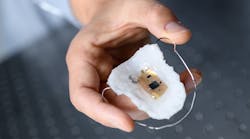To help monitor salt intake, researchers at the Georgia Technology Institute of Technology have developed a flexible and stretchable wireless sensor that can be comfortably worn in the mouth to measure the amount of sodium a person consumes. It is designed for people with hypertension and other conditions in which eating too much salt raises blood pressure and increases the likelihood of cardiac problems.
Key to development of the intraoral sensor was replacing traditional plastic and metal-based electronics with biocompatible and ultrathin components connected using mesh circuitry. Sodium sensors are available commercially, but the Georgia Tech team developed a flexible micro-membrane version that connects to miniaturized hybrid circuitry.
The entire sensing and electronics package was conformally built into a soft material users can tolerate for long periods of time when it is their mouths. The sensor monitors sodium intake in real-time, and records daily amounts. This data is transmitted to a smartphone or tablet up to 30 ft away via Bluetooth. Eventually the information could go a doctor or other medical professional for remote monitoring.
The device has been tested in three adults who wore the sensor for up to a week while eating both solid and liquid foods, including vegetable juice, chicken soup, and potato chips.
Researchers plan to further miniaturize the sensor, which now resembles a dental retainer, to the size of a tooth. They would also like to do away with the battery, which must be recharged daily to keep the sensor in operation. One option would be to power the sensor inductively, which would replace the battery and complex circuit with a coil that could receive power from a transmitter outside the mouth. The team also wants to test it on patients with medical conditions that could be linked to salt consumption, such as hypertension, obesity, and diabetes.
According to the American Heart Association, Americans on average consume more than 3,400 milligrams of sodium every day, far more than the association’s limit of 1,500 milligrams per day. The association surveyed a thousand adults and found that “one-third couldn’t estimate how much sodium they ate, and another 54% thought they were eating less than 2,000 milligrams of sodium a day.”

